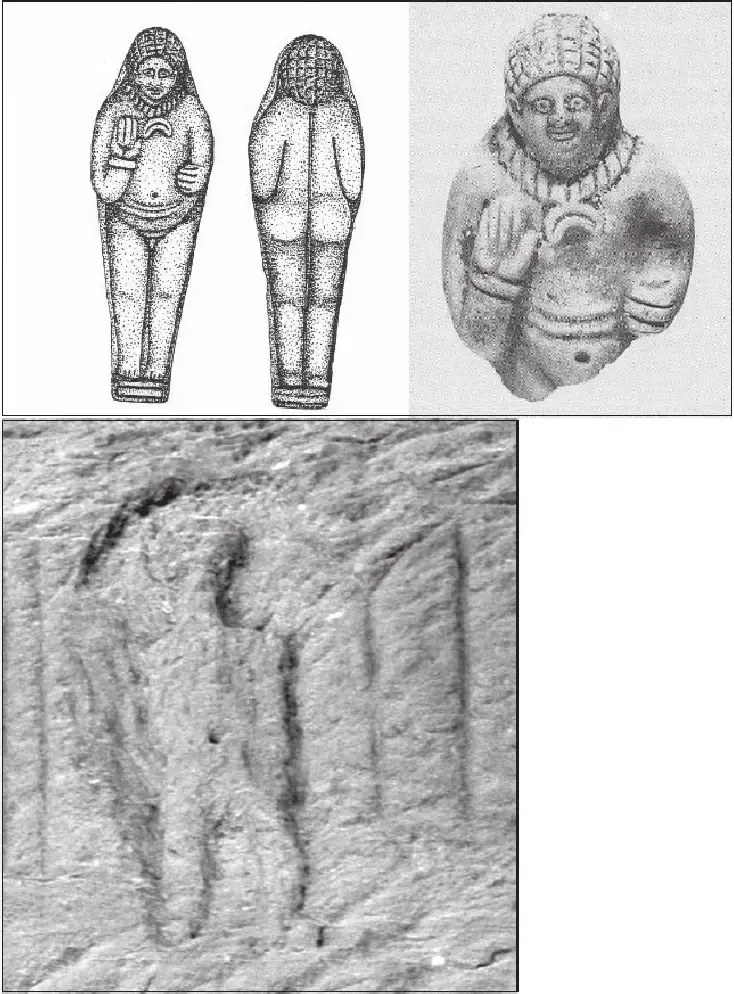Birth of Dushara
Birth of Dushara

Epiphanius of Salamis talks about the birth of Dushara from a virgin (Panarion 4th century AD) and some scholars have concluded that the figurines could represent Al-‘Uzza and Her son Dushara, although this suggestion was not adopted by other scholars. Its more likely that Epiphanius's account is of Dushara and His mother Allat, not Al-'Uzza, since Allat was given the epithet "Mother of Gods" and Al-'Uzza seems to be Dushara's consort, not mother. That being said, here is Epiphanius's report:
"The leaders of the idolaters … in many places hold a great feast on the very night of Epiphany… First of all, in Alexandria they hold festival in what is called the Coreum, which is a great temple, namely the sacred precinct of Core. They stay awake the whole night singing hymns to the idol to the accompaniment of flutes. They keep it up the entire night, and after cockcrow torchbearers descend into an underground shrine and bring up a wooden statue seated naked on a litter… They carry the statue in a circle seven times around the very center of the temple to the accompaniment of flutes, kettledrums, and hymns and thus reveling carry it back down to the place underground. Asked what the rite means, they say: Today at this hour Core (meaning the virgin) engendered Aeon. This is also done in the city of Petra ... in the temple of the idol there. They sing hymns to the virgin in Arabic, calling her in Arabic “Chaamu”, which means Core or “virgin”, and the one born from her “Dusares”…The rite is also performed in the city of Elusa on that night as in Petra and Alexandria."
The festival occurred at the winter solstice on the 6th of January and was celebrated as a mystery in several Mediterranean cultures. The birth of Dushara can be compared with the birth of Jesus as the celebration of the birth of Jesus Christ took place on the 6th of January in the East until Justinian, who in 560 AD urged the Christians in Jerusalem to adopt the earlier Roman date. This brings us back to solar imagery for the cult of Christ was often identified with the Sun among early Christian Arabs; Christ had risen at sunrise and the resurrection was equated with the rising, the second coming was expected from the east, early churches often faced the east. The birth of Mithras also occurred that night. The winter solstice was a birth of light and expressed fertility, the rebirth of vegetation. The continual rebirth of deities makes Them immortal. The concept of rebirth and resurrection was common to many ancient Semitic religions. This was particularly prevalent in Phoenician religion, where it was a part of the cult of Melqart. Melqart was often Hellenized as Adonis, and was related to the ancient Sumerian Dummuzi, biblical Tammuz, where rebirth and resurrection figured highly.
Like the mysteries at Eleusis and those of Isis and Osiris the festival must've been a profound experience. Gathering at the temple of Dushara in the evening of the 5th of January, staying the whole night, and singing hymns to the accompaniment of flutes and drums. Perhaps they partook in some entheogens or fasting or perhaps the long hours of singing and music was enough to induce a mystical experience or trance. After many hours, the first light, the Morning Star, and the rising of the sun announces the birth and epiphany of Dushara, indicated also by revealing the baetyl, which then is carried seven times in a circumambulation around the temple to be presented to all worshippers, making the epiphany public.
